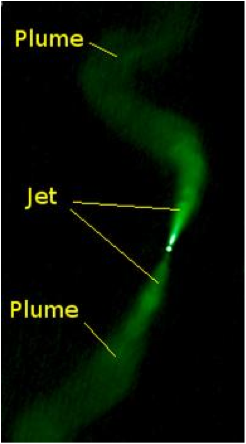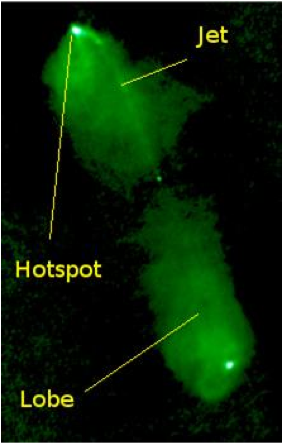Introduction
We now have a fairly good idea of how the biggest things in the observable Universe have come about. We know that the largest structures we see today- galaxies, clusters of galaxies, superclusters- are a result of gravity amplifying very small density fluctuations in the initial fabric of space-time. The mass in these structures is dominated by dark matter; although we do not yet know what particles constitute this component of the Universe, we know that it must be there, and outweigh the baryonic, or luminous, matter by a ratio of about six to one, in order to match observations. The situation with our knowledge of the evolution of the baryonic component, however, is much more problematic.
We can see this type of matter through its emission in the various
parts of the electromagnetic spectrum. Primarily this is in
the optical (corresponding to stars), X-ray (hot gas),
infra-red (stellar emission attenuated by surrounding dust) and
submillimetre/radio (gas) wavebands. If the stellar mass were to grow in step with the dark matter, we would expect to see many more extremely bright galaxies (i.e. galaxies with a large amount of stars) than we actually observe.
Since stars are formed through clumping together of cold gas, this suggests that something must be stopping the gas from cooling. Such a scenario is confirmed by observations of a lack of cold gas (expected from theoretical considerations) at the centres of the most massive galaxy clusters. A heating mechanism is clearly required.
Relativistic jets


Weak (left) and powerful (right) radio AGN. The black hole is near a bright point at the centre of each picture. Images are from A. Bridle.
Recent observations have yielded a clear favourite for this role. Almost every galaxy contains a supermassive (106 - 109 times more massive than our Sun) black hole. Most of the time these black holes are dormant, however every now and again (typically a few percent of the time) they become active and emit copious amounts of radiation. We call these objects Active Galactic Nuclei (AGNs), and their energy output can significantly affect the surrounding gas, by both heating and transporting it away from the central regions. This process is referred to as AGN feedback.
Although AGN feedback has been shown to suppress gas cooling and star formation in individual objects, the question of whether or not - and how - it fixes the global discrepancies between theory and observations is still an open one.
Over the latter half of our Universe's evolution, numerous lines of
observational and theoretical evidence unequivocally point to
relativistic jets associated with supermassive black holes as
doing this feedback.
I use a combination of analytical and numerical modelling, and
observations, to study the connection between AGN, their host
galaxies, and larger-scale environment.
RAiSE: Radio AGN in Semi-Analytic Environments
Following early theoretical work in the 1970s, in the 1990s it was
realised that the observed properties of jet-inflated structures -
commonly referred to as radio galaxies -
depend strongly on both the intrinsic jet properties (its power,
composition) and the environment into which these jets expand.
One of my major contributions has been in developing environment-sensitive
jet dynamical models. While the "gold standard" for quantifying jet
environments comes from X-ray observations, these are often not
available. Because of this, several years ago I decided to instead
turn to galaxy formation models to provide a statistical description
of the environment. Since then the
Radio AGN in Semi-analytic
Environments (RAiSE) model has been used to solve the long-standing
discrepancy
between dynamical and spectral ages, quantify the energy input
from powerful radio sources, predict X-ray emission associated
with high-redshift AGN, and even constrain
cosmological parameters.
We are currently applying RAiSE to large surveys from
leading international telescopes, constraining the energetics and duty
cycles of jet activity - and ultimately gleaning insights into the
complex jet physics.
Jet simulations
Hydrodynamic simulations can capture complex jet dynamics not
available to analytic models. In close collaboration with
colleagues at the University of Hertfordshire, we have been using the PLUTO code to describe jet
propagation in physically-motivated environments. We have found that
both the observable jet properties, and efficiency of feedback, are
strongly dependent on the environment into which the jets
expand.
Most recently we have been collaborating with colleagues at the
International Centre for Radio Astronomy Research on combining jet and cosmological
galaxy formation simulations.
Radio continuum surveys
I am embedded in most major radio surveys, to which I provide my
theoretical expertise. Some key ones include:
- GLASS. The 3000-hour GAMA
Legacy ATCA Southern Survey is the largest environment-sensitive
radio continuum survey ever conducted.
I lead the AGN and galaxy formation theory aspects
of the GLASS project, and am a member of the three-person GLASS
executive, led by PI Dr Minh Huynh.
- Radio Galaxy
Zoo.
I am Co-Lead (with Dr Ivy Wong) of this large international Citizen Science project,
completed in 2019, enlisted members of the public to visually
classify radio emission from jets near supermassive black
holes. Around 50 scientists in Europe, the Americas, Africa, and
Australasia contributed, along with several thousand volunteers.
In addition to peer-reviewed publications, these citizen scientists
contributed to several media-worthy results, including a discovery of a new cluster of galaxies. Illustrating the success of RGZ, teams at globally-leading radio telescopes (e.g. LOFAR, Netherlands; ASKAP, Australia), are now developing their own versions of this project.
- LOFAR. I collaborate with the LOw Frequency ARray surveys
key science team on understanding the mechanisms causing radio jets to switch "on"
and "off". My primary contribution is through RAiSE
modelling.
- EMU. I am a member of the Evolutionary
Map of the Universe survey on the Australian
Square Kilometre Array Pathfinder. Several PhD students in my
group have worked on both observational and theoretical projects
closely related to EMU. There is also substantial overlap between
EMU and GLASS.

Energy input from black holes (solid blue curve) at galaxy
centres explains why we don't see any more or less stars in the
biggest galaxies. Without it (coloured dashed curves) the number of stars cannot be reproduced.
Galaxy formation models
In galaxy formation theory, lack of AGN feedback produces far too many
bright galaxies compared to observations. A few years ago I wrote a paper
that showed that this problem can be circumvented by intermittenly
feeding weak AGN at the centres of galaxies. Jets from these AGN heat
and move out gas at the centre of galaxies and stop excessive star formation.
I have used observations and models to study the mechanisms of AGN
triggering. In the
low-redshift Universe, the AGN fuel
should mostly come from hot gas in massive elliptical galaxies cooling
down and funneling through to the black hole. Rarer, but still
important, is the triggering of activity through gas
compression. Finally, the most energetic outbursts come about when galaxies collide. These
galaxy-galaxy mergers are relatively rare now, but they show tantalising
signatures of black hole mergers when observed with radio
telescopes. Such merging systems should be much more prevalent in a younger Universe, when galaxies were more closely packed together.

AGN helps trigger star formation in the galaxy Centaurus A. Newly-formed stars (blue) are visible at the right tip of the image. Green emission is from gas ionized by the AGN shock.
Both star formation and AGN activity require similar conditions:
presence of cold gas. It is not surprising then that the peaks of star
formation and AGN activity in the Universe coincide at redshift 1-2. A
sudden supply of cold gas (such as in a gas-rich
merger) to a galaxy should trigger both star formation and an
AGN. I am particularly interested in the timescales associated with
these processes. We found that first
the stars form, and then the black hole switches on. The reason
these timescales are important is because the black hole can only
regulate star formation after it has switched on. Just in case
this wasn't complicated enough, in some cases AGN jets can even help
(rather than hinder) star formation!
AGN feedback is clearly a complicated process. A major focus of my
work has been to bring together jet and galaxy
formation models. Our most recent results are promising: using both galaxy and jet
observations provides much stronger constraints on possible
feedback mechanisms than either dataset alone.

